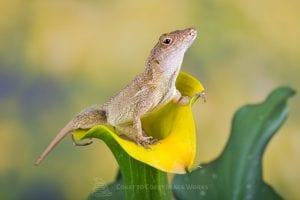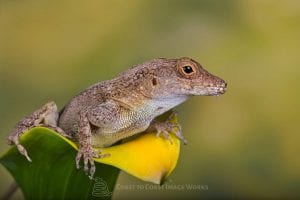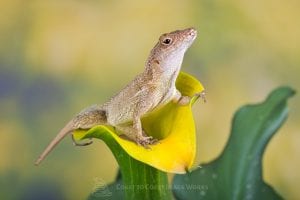 The Crested Anole is a small lizard species, but no less impressive because of it. The crest on the males puts them in the same (but miniaturised) league of Basilisks, of which they are distantly related. Growing to around 7-8cm, snout to vent (not including tail) and the ability to change colour (but not as dramatically as chameleons) from light greys to reddish browns they make stunning and interesting subjects for the vivaria. They are also relatively easily catered for, as long as some simple guidelines are followed.
The Crested Anole is a small lizard species, but no less impressive because of it. The crest on the males puts them in the same (but miniaturised) league of Basilisks, of which they are distantly related. Growing to around 7-8cm, snout to vent (not including tail) and the ability to change colour (but not as dramatically as chameleons) from light greys to reddish browns they make stunning and interesting subjects for the vivaria. They are also relatively easily catered for, as long as some simple guidelines are followed.
To keep them you will need a relatively tall vivaria, in their natural habitat in Puerto Rico they are said to inhabit the lower foliage of rainforests, up to around two metres from the ground. Certainly they will not require a vivarium this tall, but up to around 1m would be ideal. Due to their inclination to live in lower elevation rainforest in their homeland (not to be confused with their introduced status of urban dwellers in such areas as Costa Rica, Caribbean and Florida) they are well suited to a naturally planted terrarium and this will look stunning in your living room. There are some tall glass vivaria and paludaria such as the ones made by Zoo Med which are ideal. Plants suitable would include such favourites as Ficus pumillo and bromelia – a mixture of plants would look the most natural. Features such as waterfalls, bromelia laden branches full of moss will give a very impressive feature in any home. Crested Anoles require a UVB light, we would recommend a quality T5 lighting tube (such as Zoo med Reptisun) switched on for around 12 hours per day. Basking temperatures require to be around 30C, with a cooler retreat area. The heater needs to overh
to around two metres from the ground. Certainly they will not require a vivarium this tall, but up to around 1m would be ideal. Due to their inclination to live in lower elevation rainforest in their homeland (not to be confused with their introduced status of urban dwellers in such areas as Costa Rica, Caribbean and Florida) they are well suited to a naturally planted terrarium and this will look stunning in your living room. There are some tall glass vivaria and paludaria such as the ones made by Zoo Med which are ideal. Plants suitable would include such favourites as Ficus pumillo and bromelia – a mixture of plants would look the most natural. Features such as waterfalls, bromelia laden branches full of moss will give a very impressive feature in any home. Crested Anoles require a UVB light, we would recommend a quality T5 lighting tube (such as Zoo med Reptisun) switched on for around 12 hours per day. Basking temperatures require to be around 30C, with a cooler retreat area. The heater needs to overh ead, there is much debate on all the various choices of heater – choices include ceramic heaters, halogen and incandescent (amongst others). There are fans and successes for them for all forms of heaters. Humidity should pretty much look after itself, it needs to be around 90{cb5d0a8cf0c44aef2db327d9ab0dba08dd09aed1126b509e5fa01d3aaa87fe47}, the various misting systems will help with this – our favourite is the MistKing range.
ead, there is much debate on all the various choices of heater – choices include ceramic heaters, halogen and incandescent (amongst others). There are fans and successes for them for all forms of heaters. Humidity should pretty much look after itself, it needs to be around 90{cb5d0a8cf0c44aef2db327d9ab0dba08dd09aed1126b509e5fa01d3aaa87fe47}, the various misting systems will help with this – our favourite is the MistKing range.
Like many lizard species they will require daily feeding of insect livefood. Luckily there are many commercially available species such as crickets, locusts, cockroaches, waxworms – it’s good practise to offer as much variety as possible. Don’t forget to feed the livefood correctly, this is called gutloading – this will pass into the Anoles gut and give added benefit. There are various commercially balanced gut-loading diets available. A  supplement powder should be dusted onto the livefood just prior to feeding to the anoles, again this will balance the diet with extra vitamins and minerals.
supplement powder should be dusted onto the livefood just prior to feeding to the anoles, again this will balance the diet with extra vitamins and minerals.
To keep this species is, as we say, relatively easy. If you keep them in a “sterile” vivarium with plastic plants clean the vivarium out daily but spot cleaning (removing faecal matter and any shed skin). If they are kept in a natural planted terrarium, and the balance is maintained correctly it should be self-sustaining with the plants and custodians (woodlice, Springtails etc) taking away all the dirt.
A highly recommended species, especially for those interested in bio-friendly natural terraria.
